oil SKODA YETI 2015 1.G / 5L Owner's Manual
[x] Cancel search | Manufacturer: SKODA, Model Year: 2015, Model line: YETI, Model: SKODA YETI 2015 1.G / 5LPages: 232, PDF Size: 30.84 MB
Page 5 of 232
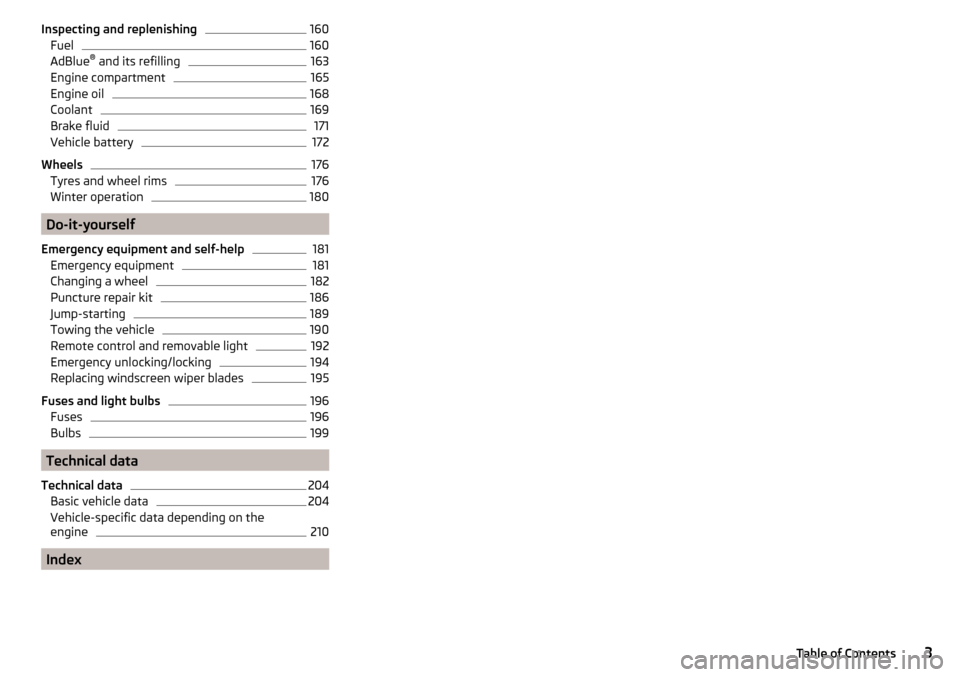
Inspecting and replenishing160Fuel160
AdBlue®
and its refilling
163
Engine compartment
165
Engine oil
168
Coolant
169
Brake fluid
171
Vehicle battery
172
Wheels
176
Tyres and wheel rims
176
Winter operation
180
Do-it-yourself
Emergency equipment and self-help
181
Emergency equipment
181
Changing a wheel
182
Puncture repair kit
186
Jump-starting
189
Towing the vehicle
190
Remote control and removable light
192
Emergency unlocking/locking
194
Replacing windscreen wiper blades
195
Fuses and light bulbs
196
Fuses
196
Bulbs
199
Technical data
Technical data
204
Basic vehicle data
204
Vehicle-specific data depending on the
engine
210
Index
3Table of Contents
Page 10 of 232
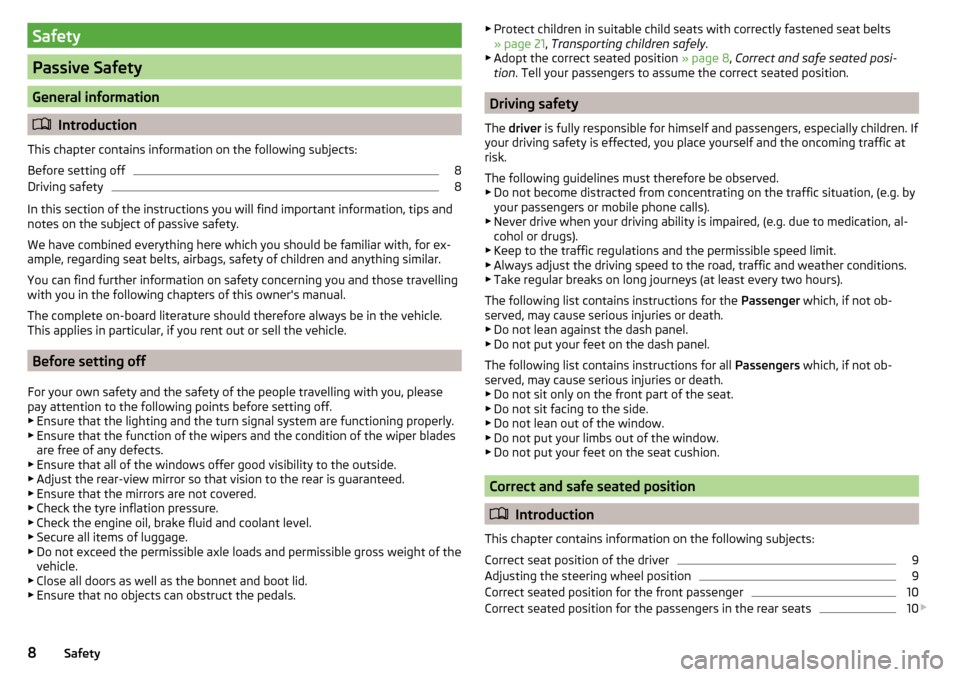
Safety
Passive Safety
General information
Introduction
This chapter contains information on the following subjects:
Before setting off
8
Driving safety
8
In this section of the instructions you will find important information, tips and
notes on the subject of passive safety.
We have combined everything here which you should be familiar with, for ex-
ample, regarding seat belts, airbags, safety of children and anything similar.
You can find further information on safety concerning you and those travelling
with you in the following chapters of this owner's manual.
The complete on-board literature should therefore always be in the vehicle. This applies in particular, if you rent out or sell the vehicle.
Before setting off
For your own safety and the safety of the people travelling with you, please
pay attention to the following points before setting off.
▶ Ensure that the lighting and the turn signal system are functioning properly.
▶ Ensure that the function of the wipers and the condition of the wiper blades
are free of any defects.
▶ Ensure that all of the windows offer good visibility to the outside.
▶ Adjust the rear-view mirror so that vision to the rear is guaranteed.
▶ Ensure that the mirrors are not covered.
▶ Check the tyre inflation pressure.
▶ Check the engine oil, brake fluid and coolant level.
▶ Secure all items of luggage.
▶ Do not exceed the permissible axle loads and permissible gross weight of the
vehicle.
▶ Close all doors as well as the bonnet and boot lid.
▶ Ensure that no objects can obstruct the pedals.
▶
Protect children in suitable child seats with correctly fastened seat belts
» page 21 , Transporting children safely .
▶ Adopt the correct seated position » page 8, Correct and safe seated posi-
tion . Tell your passengers to assume the correct seated position.
Driving safety
The driver is fully responsible for himself and passengers, especially children. If
your driving safety is effected, you place yourself and the oncoming traffic at
risk.
The following guidelines must therefore be observed. ▶ Do not become distracted from concentrating on the traffic situation, (e.g. by
your passengers or mobile phone calls).
▶ Never drive when your driving ability is impaired, (e.g. due to medication, al-
cohol or drugs).
▶ Keep to the traffic regulations and the permissible speed limit.
▶ Always adjust the driving speed to the road, traffic and weather conditions.
▶ Take regular breaks on long journeys (at least every two hours).
The following list contains instructions for the Passenger which, if not ob-
served, may cause serious injuries or death. ▶ Do not lean against the dash panel.
▶ Do not put your feet on the dash panel.
The following list contains instructions for all Passengers which, if not ob-
served, may cause serious injuries or death. ▶ Do not sit only on the front part of the seat.
▶ Do not sit facing to the side.
▶ Do not lean out of the window.
▶ Do not put your limbs out of the window.
▶ Do not put your feet on the seat cushion.
Correct and safe seated position
Introduction
This chapter contains information on the following subjects:
Correct seat position of the driver
9
Adjusting the steering wheel position
9
Correct seated position for the front passenger
10
Correct seated position for the passengers in the rear seats
10
8Safety
Page 13 of 232
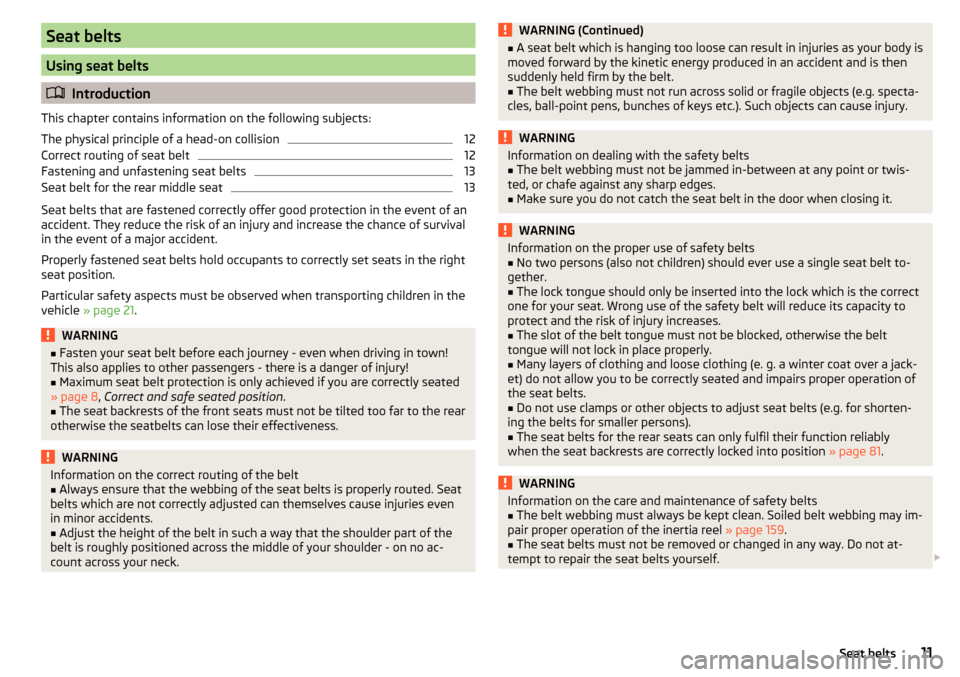
Seat belts
Using seat belts
Introduction
This chapter contains information on the following subjects:
The physical principle of a head-on collision
12
Correct routing of seat belt
12
Fastening and unfastening seat belts
13
Seat belt for the rear middle seat
13
Seat belts that are fastened correctly offer good protection in the event of an
accident. They reduce the risk of an injury and increase the chance of survival
in the event of a major accident.
Properly fastened seat belts hold occupants to correctly set seats in the right
seat position.
Particular safety aspects must be observed when transporting children in the
vehicle » page 21 .
WARNING■
Fasten your seat belt before each journey - even when driving in town!
This also applies to other passengers - there is a danger of injury!■
Maximum seat belt protection is only achieved if you are correctly seated
» page 8 , Correct and safe seated position .
■
The seat backrests of the front seats must not be tilted too far to the rear
otherwise the seatbelts can lose their effectiveness.
WARNINGInformation on the correct routing of the belt■Always ensure that the webbing of the seat belts is properly routed. Seat
belts which are not correctly adjusted can themselves cause injuries even
in minor accidents.■
Adjust the height of the belt in such a way that the shoulder part of the
belt is roughly positioned across the middle of your shoulder - on no ac-
count across your neck.
WARNING (Continued)■ A seat belt which is hanging too loose can result in injuries as your body is
moved forward by the kinetic energy produced in an accident and is then
suddenly held firm by the belt.■
The belt webbing must not run across solid or fragile objects (e.g. specta-
cles, ball-point pens, bunches of keys etc.). Such objects can cause injury.
WARNINGInformation on dealing with the safety belts■The belt webbing must not be jammed in-between at any point or twis-
ted, or chafe against any sharp edges.■
Make sure you do not catch the seat belt in the door when closing it.
WARNINGInformation on the proper use of safety belts■No two persons (also not children) should ever use a single seat belt to-
gether.■
The lock tongue should only be inserted into the lock which is the correct
one for your seat. Wrong use of the safety belt will reduce its capacity to
protect and the risk of injury increases.
■
The slot of the belt tongue must not be blocked, otherwise the belt
tongue will not lock in place properly.
■
Many layers of clothing and loose clothing (e. g. a winter coat over a jack-
et) do not allow you to be correctly seated and impairs proper operation of
the seat belts.
■
Do not use clamps or other objects to adjust seat belts (e.g. for shorten-
ing the belts for smaller persons).
■
The seat belts for the rear seats can only fulfil their function reliably
when the seat backrests are correctly locked into position » page 81.
WARNINGInformation on the care and maintenance of safety belts■The belt webbing must always be kept clean. Soiled belt webbing may im-
pair proper operation of the inertia reel » page 159.■
The seat belts must not be removed or changed in any way. Do not at-
tempt to repair the seat belts yourself.
11Seat belts
Page 33 of 232
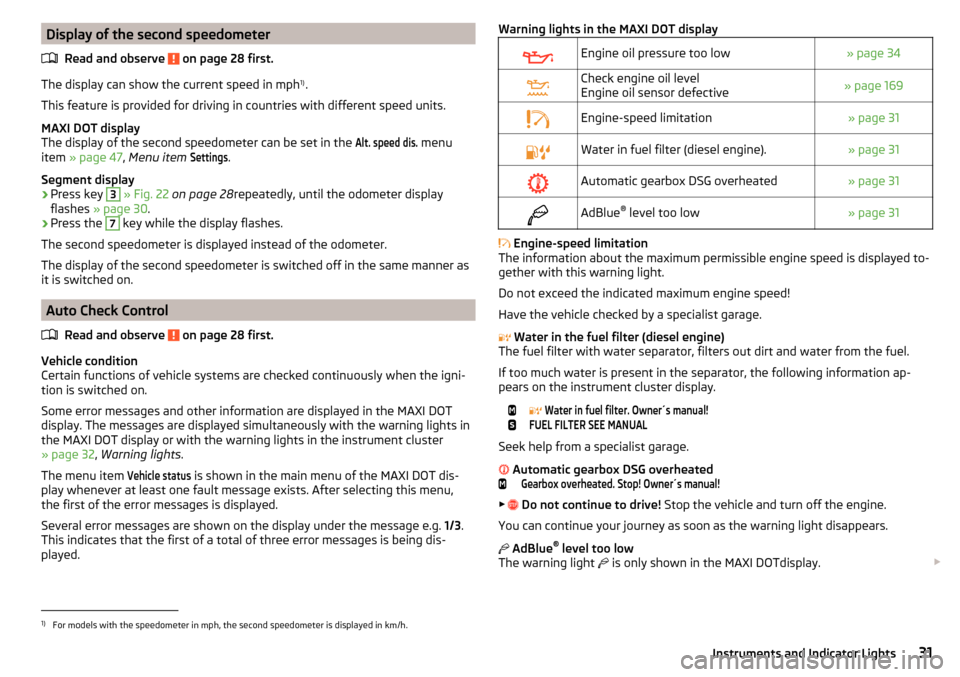
Display of the second speedometerRead and observe
on page 28 first.
The display can show the current speed in mph 1)
.
This feature is provided for driving in countries with different speed units.
MAXI DOT display
The display of the second speedometer can be set in the
Alt. speed dis.
menu
item » page 47 , Menu item
Settings
.
Segment display
›
Press key
3
» Fig. 22 on page 28 repeatedly, until the odometer display
flashes » page 30 .
›
Press the
7
key while the display flashes.
The second speedometer is displayed instead of the odometer.
The display of the second speedometer is switched off in the same manner as
it is switched on.
Auto Check Control
Read and observe
on page 28 first.
Vehicle condition
Certain functions of vehicle systems are checked continuously when the igni- tion is switched on.
Some error messages and other information are displayed in the MAXI DOT
display. The messages are displayed simultaneously with the warning lights in
the MAXI DOT display or with the warning lights in the instrument cluster
» page 32 , Warning lights .
The menu item
Vehicle status
is shown in the main menu of the MAXI DOT dis-
play whenever at least one fault message exists. After selecting this menu,
the first of the error messages is displayed.
Several error messages are shown on the display under the message e.g. 1/3.
This indicates that the first of a total of three error messages is being dis-
played.
Warning lights in the MAXI DOT displayEngine oil pressure too low» page 34Check engine oil level
Engine oil sensor defective» page 169Engine-speed limitation» page 31Water in fuel filter (diesel engine).» page 31Automatic gearbox DSG overheated» page 31AdBlue ®
level too low» page 31
Engine-speed limitation
The information about the maximum permissible engine speed is displayed to-
gether with this warning light.
Do not exceed the indicated maximum engine speed!
Have the vehicle checked by a specialist garage.
Water in the fuel filter (diesel engine)
The fuel filter with water separator, filters out dirt and water from the fuel.
If too much water is present in the separator, the following information ap-
pears on the instrument cluster display.
Water in fuel filter. Owner´s manual!FUEL FILTER SEE MANUAL
Seek help from a specialist garage.
Automatic gearbox DSG overheated
Gearbox overheated. Stop! Owner´s manual!
▶
Do not continue to drive! Stop the vehicle and turn off the engine.
You can continue your journey as soon as the warning light disappears.
AdBlue ®
level too low
The warning light is only shown in the MAXI DOTdisplay.
1)
For models with the speedometer in mph, the second speedometer is displayed in km/h.
31Instruments and Indicator Lights
Page 36 of 232
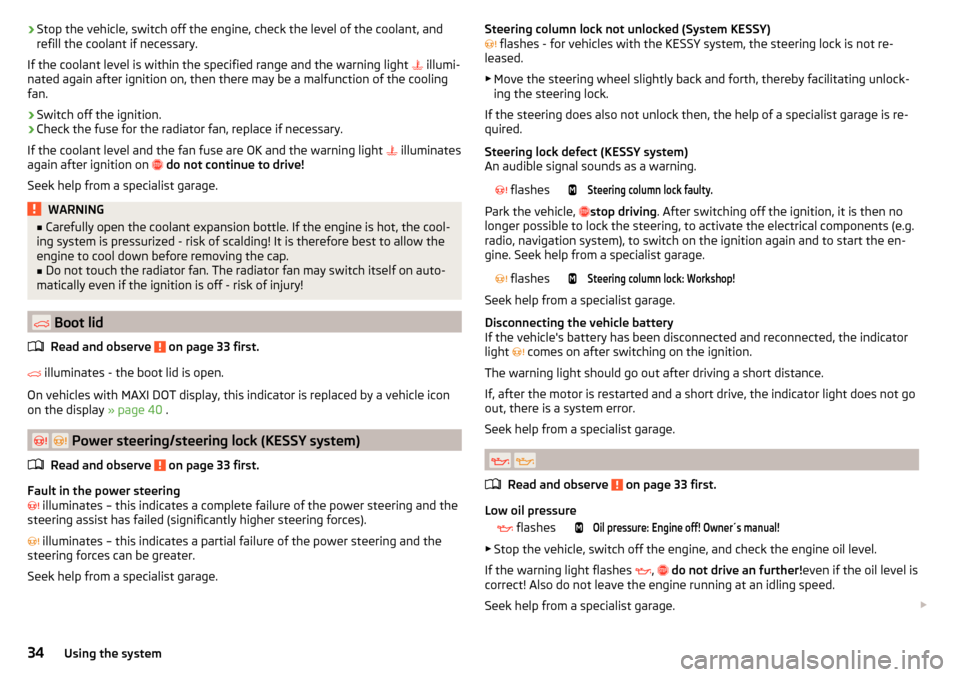
›Stop the vehicle, switch off the engine, check the level of the coolant, and
refill the coolant if necessary.
If the coolant level is within the specified range and the warning light
illumi-
nated again after ignition on, then there may be a malfunction of the cooling
fan.›
Switch off the ignition.
›
Check the fuse for the radiator fan, replace if necessary.
If the coolant level and the fan fuse are OK and the warning light
illuminates
again after ignition on
do not continue to drive!
Seek help from a specialist garage.
WARNING■ Carefully open the coolant expansion bottle. If the engine is hot, the cool-
ing system is pressurized - risk of scalding! It is therefore best to allow the
engine to cool down before removing the cap.■
Do not touch the radiator fan. The radiator fan may switch itself on auto-
matically even if the ignition is off - risk of injury!
Boot lid
Read and observe
on page 33 first.
illuminates - the boot lid is open.
On vehicles with MAXI DOT display, this indicator is replaced by a vehicle icon
on the display » page 40 .
Power steering/steering lock (KESSY system)
Read and observe
on page 33 first.
Fault in the power steering
illuminates – this indicates a complete failure of the power steering and the
steering assist has failed (significantly higher steering forces).
illuminates – this indicates a partial failure of the power steering and the
steering forces can be greater.
Seek help from a specialist garage.
Steering column lock not unlocked (System KESSY) flashes - for vehicles with the KESSY system, the steering lock is not re-
leased.
▶ Move the steering wheel slightly back and forth, thereby facilitating unlock-
ing the steering lock.
If the steering does also not unlock then, the help of a specialist garage is re-
quired.
Steering lock defect (KESSY system)
An audible signal sounds as a warning. flashesSteering column lock faulty.
Park the vehicle,
stop driving
. After switching off the ignition, it is then no
longer possible to lock the steering, to activate the electrical components (e.g.
radio, navigation system), to switch on the ignition again and to start the en-
gine. Seek help from a specialist garage.
flashesSteering column lock: Workshop!
Seek help from a specialist garage.
Disconnecting the vehicle battery
If the vehicle's battery has been disconnected and reconnected, the indicator
light comes on after switching on the ignition.
The warning light should go out after driving a short distance.
If, after the motor is restarted and a short drive, the indicator light does not go
out, there is a system error.
Seek help from a specialist garage.
Read and observe on page 33 first.
Low oil pressure
flashesOil pressure: Engine off! Owner´s manual!
▶
Stop the vehicle, switch off the engine, and check the engine oil level.
If the warning light flashes ,
do not drive an further! even if the oil level is
correct! Also do not leave the engine running at an idling speed.
Seek help from a specialist garage.
34Using the system
Page 37 of 232
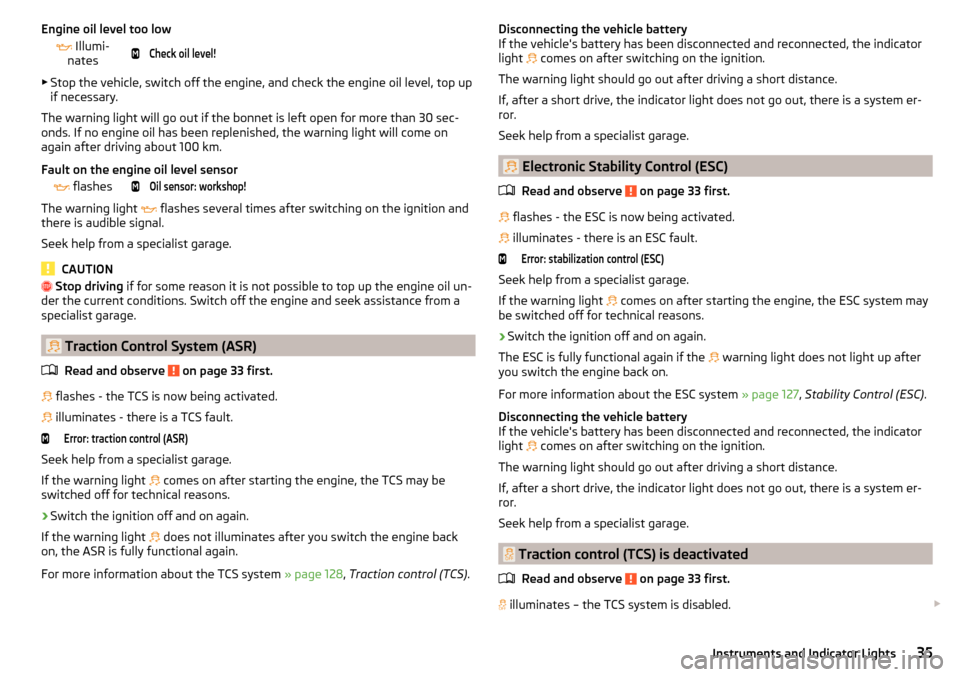
Engine oil level too low Illumi-
nates
Check oil level!
▶ Stop the vehicle, switch off the engine, and check the engine oil level, top up
if necessary.
The warning light will go out if the bonnet is left open for more than 30 sec-
onds. If no engine oil has been replenished, the warning light will come on
again after driving about 100 km.
Fault on the engine oil level sensor
flashesOil sensor: workshop!
The warning light
flashes several times after switching on the ignition and
there is audible signal.
Seek help from a specialist garage.
CAUTION
Stop driving if for some reason it is not possible to top up the engine oil un-
der the current conditions. Switch off the engine and seek assistance from a
specialist garage.
Traction Control System (ASR)
Read and observe
on page 33 first.
flashes - the TCS is now being activated.
illuminates - there is a TCS fault.
Error: traction control (ASR)
Seek help from a specialist garage.
If the warning light comes on after starting the engine, the TCS may be
switched off for technical reasons.
›
Switch the ignition off and on again.
If the warning light does not illuminates after you switch the engine back
on, the ASR is fully functional again.
For more information about the TCS system » page 128, Traction control (TCS) .
Disconnecting the vehicle battery
If the vehicle's battery has been disconnected and reconnected, the indicator
light
comes on after switching on the ignition.
The warning light should go out after driving a short distance.
If, after a short drive, the indicator light does not go out, there is a system er-
ror.
Seek help from a specialist garage.
Electronic Stability Control (ESC)
Read and observe
on page 33 first.
flashes - the ESC is now being activated.
illuminates - there is an ESC fault.
Error: stabilization control (ESC)
Seek help from a specialist garage.
If the warning light comes on after starting the engine, the ESC system may
be switched off for technical reasons.
›
Switch the ignition off and on again.
The ESC is fully functional again if the warning light does not light up after
you switch the engine back on.
For more information about the ESC system » page 127, Stability Control (ESC) .
Disconnecting the vehicle battery
If the vehicle's battery has been disconnected and reconnected, the indicator
light comes on after switching on the ignition.
The warning light should go out after driving a short distance.
If, after a short drive, the indicator light does not go out, there is a system er-
ror.
Seek help from a specialist garage.
Traction control (TCS) is deactivated
Read and observe
on page 33 first.
illuminates – the TCS system is disabled.
35Instruments and Indicator Lights
Page 44 of 232
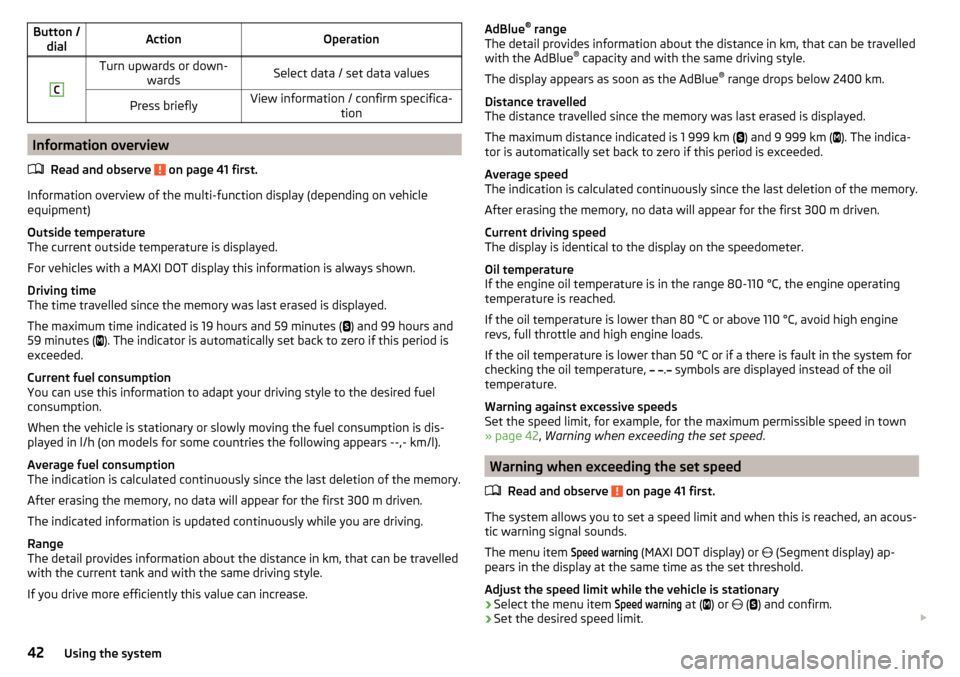
Button /dialActionOperationCTurn upwards or down- wardsSelect data / set data valuesPress brieflyView information / confirm specifica- tion
Information overview
Read and observe
on page 41 first.
Information overview of the multi-function display (depending on vehicle
equipment)
Outside temperature
The current outside temperature is displayed.
For vehicles with a MAXI DOT display this information is always shown.
Driving time
The time travelled since the memory was last erased is displayed.
The maximum time indicated is 19 hours and 59 minutes ( ) and 99 hours and
59 minutes ( ). The indicator is automatically set back to zero if this period is
exceeded.
Current fuel consumption
You can use this information to adapt your driving style to the desired fuel
consumption.
When the vehicle is stationary or slowly moving the fuel consumption is dis-
played in l/h (on models for some countries the following appears --,- km/l).
Average fuel consumption
The indication is calculated continuously since the last deletion of the memory.
After erasing the memory, no data will appear for the first 300 m driven.
The indicated information is updated continuously while you are driving.
Range
The detail provides information about the distance in km, that can be travelled
with the current tank and with the same driving style.
If you drive more efficiently this value can increase.
AdBlue ®
range
The detail provides information about the distance in km, that can be travelled
with the AdBlue ®
capacity and with the same driving style.
The display appears as soon as the AdBlue ®
range drops below 2400 km.
Distance travelled
The distance travelled since the memory was last erased is displayed.
The maximum distance indicated is 1 999 km (
) and 9 999 km (
). The indica-
tor is automatically set back to zero if this period is exceeded.
Average speed
The indication is calculated continuously since the last deletion of the memory.
After erasing the memory, no data will appear for the first 300 m driven.
Current driving speed
The display is identical to the display on the speedometer.
Oil temperature
If the engine oil temperature is in the range 80-110 °C, the engine operating temperature is reached.
If the oil temperature is lower than 80 °C or above 110 °C, avoid high engine
revs, full throttle and high engine loads.
If the oil temperature is lower than 50 °C or if a there is fault in the system for
checking the oil temperature,
.
symbols are displayed instead of the oil
temperature.
Warning against excessive speeds
Set the speed limit, for example, for the maximum permissible speed in town
» page 42 , Warning when exceeding the set speed .
Warning when exceeding the set speed
Read and observe
on page 41 first.
The system allows you to set a speed limit and when this is reached, an acous-
tic warning signal sounds.
The menu item
Speed warning
(MAXI DOT display) or (Segment display) ap-
pears in the display at the same time as the set threshold.
Adjust the speed limit while the vehicle is stationary
›
Select the menu item
Speed warning
at ( ) or
(
) and confirm.
›
Set the desired speed limit.
42Using the system
Page 50 of 232
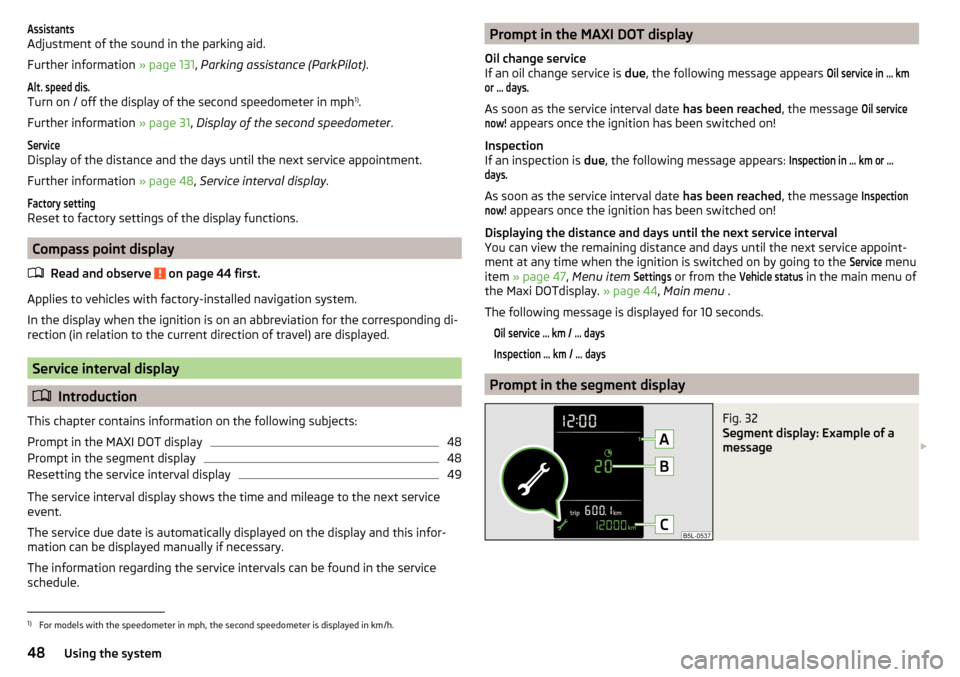
Assistants
Adjustment of the sound in the parking aid.
Further information » page 131, Parking assistance (ParkPilot) .
Alt. speed dis.
Turn on / off the display of the second speedometer in mph 1)
.
Further information » page 31, Display of the second speedometer .
Service
Display of the distance and the days until the next service appointment.
Further information » page 48, Service interval display .
Factory setting
Reset to factory settings of the display functions.
Compass point display
Read and observe
on page 44 first.
Applies to vehicles with factory-installed navigation system.
In the display when the ignition is on an abbreviation for the corresponding di-
rection (in relation to the current direction of travel) are displayed.
Service interval display
Introduction
This chapter contains information on the following subjects:
Prompt in the MAXI DOT display
48
Prompt in the segment display
48
Resetting the service interval display
49
The service interval display shows the time and mileage to the next service
event.
The service due date is automatically displayed on the display and this infor-
mation can be displayed manually if necessary.
The information regarding the service intervals can be found in the service
schedule.
Prompt in the MAXI DOT display
Oil change service
If an oil change service is due, the following message appears Oil service in … kmor … days.
As soon as the service interval date has been reached, the message
Oil servicenow!
appears once the ignition has been switched on!
Inspection
If an inspection is due, the following message appears:
Inspection in … km or …days.
As soon as the service interval date has been reached, the message
Inspectionnow!
appears once the ignition has been switched on!
Displaying the distance and days until the next service interval
You can view the remaining distance and days until the next service appoint- ment at any time when the ignition is switched on by going to the
Service
menu
item » page 47 , Menu item
Settings
or from the
Vehicle status
in the main menu of
the Maxi DOTdisplay. » page 44, Main menu .
The following message is displayed for 10 seconds.
Oil service … km / … daysInspection … km / … days
Prompt in the segment display
Fig. 32
Segment display: Example of a
message
1)
For models with the speedometer in mph, the second speedometer is displayed in km/h.
48Using the system
Page 51 of 232
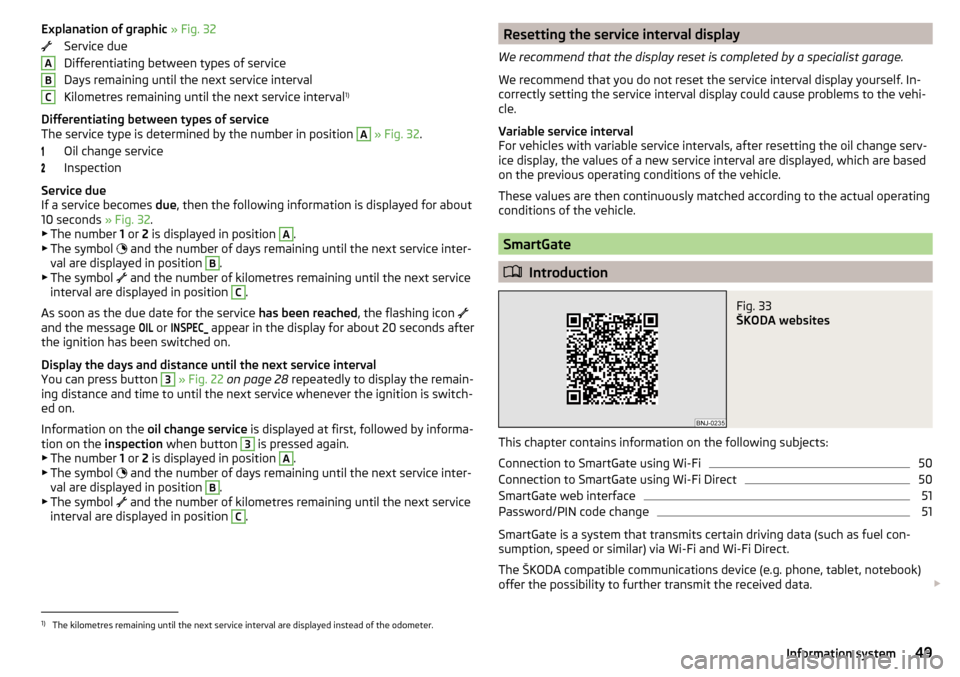
Explanation of graphic » Fig. 32
Service due
Differentiating between types of service
Days remaining until the next service interval
Kilometres remaining until the next service interval 1)
Differentiating between types of service
The service type is determined by the number in position A
» Fig. 32 .
Oil change service
Inspection
Service due
If a service becomes due, then the following information is displayed for about
10 seconds » Fig. 32.
▶ The number 1 or 2 is displayed in position
A
.
▶ The symbol and the number of days remaining until the next service inter-
val are displayed in position
B
.
▶ The symbol and the number of kilometres remaining until the next service
interval are displayed in position
C
.
As soon as the due date for the service has been reached, the flashing icon
and the message
OIL
or
INSPEC_
appear in the display for about 20 seconds after
the ignition has been switched on.
Display the days and distance until the next service interval
You can press button
3
» Fig. 22 on page 28 repeatedly to display the remain-
ing distance and time to until the next service whenever the ignition is switch-
ed on.
Information on the oil change service is displayed at first, followed by informa-
tion on the inspection when button
3
is pressed again.
▶ The number 1 or 2 is displayed in position
A
.
▶ The symbol and the number of days remaining until the next service inter-
val are displayed in position
B
.
▶ The symbol and the number of kilometres remaining until the next service
interval are displayed in position
C
.
ABCResetting the service interval display
We recommend that the display reset is completed by a specialist garage.
We recommend that you do not reset the service interval display yourself. In-
correctly setting the service interval display could cause problems to the vehi-
cle.
Variable service interval
For vehicles with variable service intervals, after resetting the oil change serv-
ice display, the values of a new service interval are displayed, which are based
on the previous operating conditions of the vehicle.
These values are then continuously matched according to the actual operating
conditions of the vehicle.
SmartGate
Introduction
Fig. 33
ŠKODA websites
This chapter contains information on the following subjects:
Connection to SmartGate using Wi-Fi
50
Connection to SmartGate using Wi-Fi Direct
50
SmartGate web interface
51
Password/PIN code change
51
SmartGate is a system that transmits certain driving data (such as fuel con-
sumption, speed or similar) via Wi-Fi and Wi-Fi Direct.
The ŠKODA compatible communications device (e.g. phone, tablet, notebook)
offer the possibility to further transmit the received data.
1)
The kilometres remaining until the next service interval are displayed instead of the odometer.
49Information system
Page 81 of 232
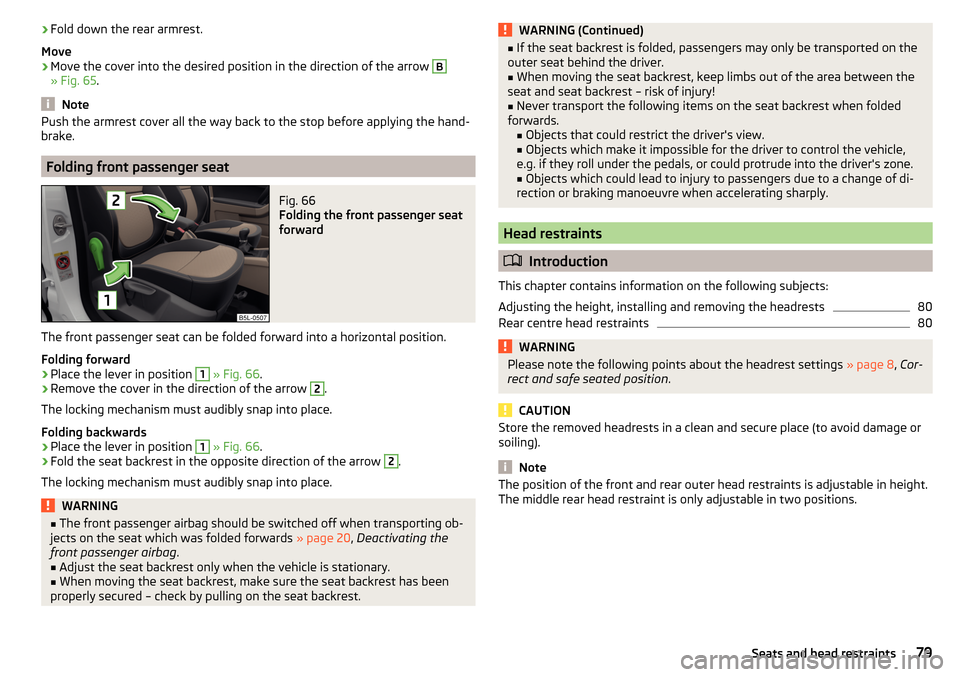
›Fold down the rear armrest.
Move›
Move the cover into the desired position in the direction of the arrow
B
» Fig. 65 .
Note
Push the armrest cover all the way back to the stop before applying the hand-
brake.
Folding front passenger seat
Fig. 66
Folding the front passenger seat
forward
The front passenger seat can be folded forward into a horizontal position.
Folding forward
›
Place the lever in position
1
» Fig. 66 .
›
Remove the cover in the direction of the arrow
2
.
The locking mechanism must audibly snap into place.
Folding backwards
›
Place the lever in position
1
» Fig. 66 .
›
Fold the seat backrest in the opposite direction of the arrow
2
.
The locking mechanism must audibly snap into place.
WARNING■ The front passenger airbag should be switched off when transporting ob-
jects on the seat which was folded forwards » page 20, Deactivating the
front passenger airbag .■
Adjust the seat backrest only when the vehicle is stationary.
■
When moving the seat backrest, make sure the seat backrest has been
properly secured – check by pulling on the seat backrest.
WARNING (Continued)■ If the seat backrest is folded, passengers may only be transported on the
outer seat behind the driver.■
When moving the seat backrest, keep limbs out of the area between the
seat and seat backrest – risk of injury!
■
Never transport the following items on the seat backrest when folded
forwards. ■Objects that could restrict the driver's view.
■ Objects which make it impossible for the driver to control the vehicle,
e.g. if they roll under the pedals, or could protrude into the driver's zone. ■ Objects which could lead to injury to passengers due to a change of di-
rection or braking manoeuvre when accelerating sharply.
Head restraints
Introduction
This chapter contains information on the following subjects:
Adjusting the height, installing and removing the headrests
80
Rear centre head restraints
80WARNINGPlease note the following points about the headrest settings » page 8, Cor-
rect and safe seated position .
CAUTION
Store the removed headrests in a clean and secure place (to avoid damage or
soiling).
Note
The position of the front and rear outer head restraints is adjustable in height.
The middle rear head restraint is only adjustable in two positions.79Seats and head restraints